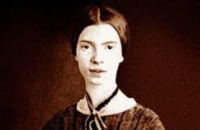Emily Dickinson
Country
United States
Birth - Death
1830 - 1886
Occupation
Poet
Description
Regarded as America’s greatest poet, Emily Dickinson introduced new and bold styles of poetry that experimented with off-rhyme, punctuation, and metaphor. This captured the public’s attention late in her life, but the full extent of her work only became appreciated after her death. The feminist movement, in particular, has adopted her work in popular culture.
Born into a wealthy and influential Massachusetts family (her grandfather was a founder of Amherst College), Emily Dickinson studied classical literature, history, and Latin at an early age. On graduation, she became acquainted with the works of William Wordsworth and Ralph Waldo Emerson which became her inspiration for experimenting with poetry.
In the 1850s, Dickinson became a close acquaintance to her sister-in-law Susan Gilbert Dickinson, the individual with whom she would develop the closest relationship through the remainder of her life. Emily wrote extensively and passionately to her, a correspondence which all biographers confirm as indicative of a lesbian relationship. Susan Dickinson provided Emily with the inspiration for her most deeply emotional poetry.
At an early age, Emily Dickinson’s health declined rapidly, to the extent that, from the age of thirty, she became a recluse in her parent’s home. During this time she extensively wrote poetry. She acquired certain notoriety for her mysterious and invisible livelihood. Nevertheless, she took on the task of organizing and cataloguing her poetry with relish, though she did not publicize the activity nor the poems themselves. Fewer than a dozen poems were published in her lifetime, though these were all met with critical acclaim.
After her death at a relatively young age, her executors followed her instructions to destroy her personal correspondence. However, no such instructions existed for her 40 volumes of well-organized poetry and writing, and they remain intact today. The first volume of these collections was published in 1890 and it was both a critical and financial success. The volume went through eleven printings in only two years.
The bulk of her poetry, edited by Thomas Johnson, was not published until 1955. Her reputation as America’s greatest poet was subsequently created. This is particularly because of the unusual syntax and punctuation embedded in her poetry that, in turn, creates a unique and unusual form for the art. These innovations were a deliberate effort by Dickinson who, during her lifetime, carefully instructed it to be maintained so as not to alter the intended meaning or interpretation of the poetry. Critics have argued that this form more clearly reveals the aesthetic insight of Dickinson’s work, which displays an extraordinary grasp and insight into its topics of morbidity, flowers and gardens, religion, and imagination.
The feminist community has adopted Dickinson’s work as part of their movement. Dickinson is heralded by this community as the greatest woman poet of the English language. Her inventive poems created the modern style of poetry that we know today. Dickinson as a woman comes through powerfully in her poetry. It is generally believed that the power of this evocation has come from her lesbian orientation, and in particular from her relationship and infatuation with her sister-in-law Susan Dickinson.
Emily Dickinson considered each of her poems as pieces of art. This is why she was so assiduous in organizing them into journals, was so specific about their care after her death, and was so meticulous in detailing how they were to be unaltered and read in the context to which she had written them. Her poems contain intense passion, most often directed to women, and Susan Dickinson was the primary recipient of these – Dickinson had to use poetry as her medium of expression because of Susan’s marriage to Emily’s brother. Her reclusiveness later in life seemed to generate even more emotion and romantic gestures, suggesting an intense frustration with her feelings amidst knowledge of their unacceptance in society. Dickinson’s poetry clearly displays mastery over her own feelings and, through her unusual syntax and punctuation, an intention to reveal the mastery of the poet over the reader.

